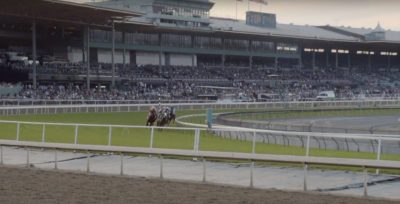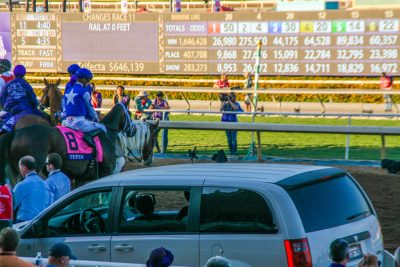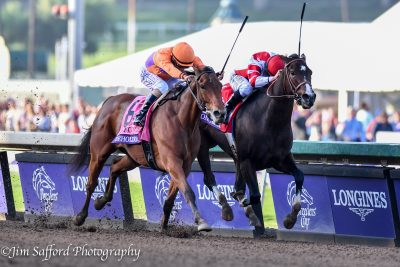
Santa Anita Park’s winter/spring meeting kicks off on Dec. 26 (photo via YouTube).
Horseracing fans get the gift they really want—albeit one day late — every year when the SoCal winter racing season celebrates its traditional official opening day on Dec. 26. That date annually kicks off not only one of the country’s premier annual winter race meets, but actually one of the year’s best race meets of any season.
The Santa Anita winter-spring meet will continue until Santa Anita Derby Weekend, with the running of the Santa Anita Derby and five other stakes on April 6, followed by closing day on April 7. Along the way, a long list a 60 stakes races will be run in every non-juvenile division, including 34 Graded stakes with eight Grade 1 races headlined by the 82nd running of the $500,000 Santa Anita Handicap — which is expected to draw a field that includes Breeders’ Cup Classic champion, Accelerate — on March 9.
Of course, any meet — big or small — is always a lot better when you win, so let’s get to know “The Great Race Place” by taking a quick look at some prevailing biases at the Santa Anita in various kinds of races.
Santa Anita Winning Track Profile

Santa Anita Park (photo by Derek Simon).
In terms of running style preferences and the winning track profile on the main track at Santa Anita, speed tends to be very good in the shorter sprints, particularly 5 ½ furlongs and 6 furlongs. At 5 ½ furlongs, about 40 percent of the winners can be expected to go wire-to-wire, and even at the most commonly run sprint distance of six panels, frontrunners still win one-third of the races.
Really, early-speed types tend to enjoy a tactical advantage at all distances on the main track. The best distance to bet off-the-pace runners is at one mile, where front runners win only 25 percent of the time, while pace pressers and even close-up stalkers do best.
Santa Anita is generally a very formful track in relation to many other places. The most recent SA winter meet in 2018 featured 36 percent winning favorites and favorites finishing in the money 70 percent of the time. The average winning odds were just a couple cents under 5-1.
Santa Anita’s main track is not particularly well known for having a lot of post position biases and angles, but the track does actually favor certain posts at certain distances. During the Santa Anita meet, some post position preferences spring up at various distances. Based on past statistics the inside posts usually are preferred, but that was not the case in 2018, when middle posts did the best in dirt sprints.
In route races, the rail post was the place to be in 2018 at both one mile and 1 1/16 miles. Beyond the rail being good, you usually do not see much bias in terms of post positions until you get to the far outside posts, which can occasionally be a disadvantage outside post eight in two-turn races.
Santa Anita Turf Racing

Breeders’ Cup 2016 at Santa Anita Park (photo by Jim Safford).
Santa Anita’s turf course is home to some of the best grass racing conducted in America, particularly over the winter. Santa Anita’s grass course generally plays very fairly to all running styles and running paths, with horses routinely being able to win races both on the lead (19 percent wire-to-wire winners in SA turf routes) or from various margins off the pace as well. Obviously, it is better to save as much ground as possible and stay within a workable striking distance of the lead — this is evidenced by the fact that the rail is the preferred post draw in SA turf routes and the inside posts outperform the middle and outside posts in terms of win percentage.
Deep closers can win, but often they lose too much ground making those wide, late moves and that gives the leaders, pressers and stalkers a good shot at holding on in the relatively short Santa Anita grass course stretch run. Days when the turf is less-than-firm provide the best chance for winners to come from a bit further off the pace.
And then there are the turf sprints. Santa Anita is the North American capital of turf sprints, thanks to its unique down-the-hill turf course, which allows the track to card its signature 6 ½-furlong downhill turf races. These races offer wide appeal for both horsemen and bettors and have long been a part of what makes the Great Race Place so great. Santa Anita has also experimented with shorter turf sprints as well, so those will be something to keep an eye out for moving forward.
Due to the uniqueness of the downhill course, SA turf sprints are often won by tried-and-true horses-for-the-course, who often have already won one or more turf sprints on this course. Some other horses, meanwhile, repeatedly have trouble crossing over the main track coming into the stretch and don’t find the downhill races to be their cup of tea.
The 6 1/2-furlong turf sprints tend to play fairly to all running styles and also tend to pose problems for horses that draw far inside posts. Santa Anita’s downhill turf course features North American racing’s only right-hand turn, which comes up quick (about a half-furlong out of the gate). Since the first turn in these races is a right turn, instead of a left turn, the inside posts essentially become the outside posts and vice versa. Outside and middle posts have long been considered an advantage in Santa Anita turf sprints, while, conversely, the inside posts — particularly posts 1, 2, 3 — are considered a significant disadvantage. This disadvantage gets worse in larger fields.
Wrap-Up
Pay close attention to the winning profiles at Santa Anita and you will have a leg-up on the betting public at Santa Anita. Most of all, have a great season at The Great Race Place, and best of luck at Santa Anita!




